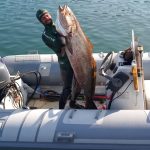By RelishPortugal.com/Evanne Schmarder
Is it a clamshell-shaped cooking vessel or a delectable dish? This Algarvian treasure is both. Along the southern coast of Portugal, bathed by the Atlantic Ocean, the cataplana is recognised as an iconic local cuisine prepared in a beautifully handcrafted pan.
Little is known about the origins of the cataplana. There are very few historical records about its creation but many believe that the cataplana can be traced to the eighth-century Moorish occupation and a concept not unique to the clamshell pan. Slow steam cooking at low temperature in a sealed container, as is the case with the cataplana, is also found in another cooking vessel, the clay tagine, traditionally used by some North African peoples.
CATAPLANA AS COOKWARE
Wandering historic Algarve streets brimming with dining establishments that spill out onto the cobbled sidewalks, you’re bound to see a cataplana pan. The two shining sides of the clamshell-shaped pan are held together with a hinge and clamps, ensuring a steamy, pressure-cooking-style cooking environment. Often it’s served with a flourish as the clamp is released and the fragrant scent wafts across the table. The resulting dish is rich and flavorful, a feast for the senses.
This delightful piece of Portuguese cookware comes in a variety of sizes and materials. Traditional cataplana pans are made of copper (they were originally made of zinc, but no more), a very efficient heat distributing metal, hammered for beauty and craftsmanship, and lined with tin. You can also find stainless steel cataplanas, both a pleasure to cook with and a beauty to behold.
Pay attention to your cooktop when choosing a cataplana, making sure it’s compatible. For example, copper cannot be used on induction cooktops. Important to know.
Ranging in size from a small single-serving 9cm to a 24cm, easily feeding two to a crowd-sized 86cm (not a typo!), be generous when choosing a size. If you’re unsure, go one larger than you think you need. To a certain extent, you can reduce the ingredients to feed fewer but cannot effectively cook more than your cataplana is designed to hold.
Depending on where and from whom you buy your cataplana cooking vessel, expect to spend somewhere starting around 32€ for an 18cm pan to 90€ for a 36cm version. You can also purchase a cork trivet allowing you to present and serve your gorgeous cataplana at the table.
COOKING CATAPLANA
It’s imagined that the fishermen, hunters, and nomads of ancient times filled cataplana pans with garlic, onions, herbs, vegetables, and olive oil and sealed them shut for transport as they began their working day. Later, adding their catch to the pan, they cooked their cataplana over glowing embers as the sun began to set. Romantic and practical, right?
Cooking cataplana is easy and streamlined. Aromatics are sautéed in the bottom of the pan, ingredients are layered, liquid is added, and the pan is sealed shut with its attached hinges and sidelocks. The pan is then placed on a heat source, in essence steaming the contents, locking in flavour, and delivering a moist, delicious meal.
Chances are you already have everything you need to make cataplana in your kitchen: olive oil, dry white wine, onion, garlic, green and/or red pepper, coriander, tomatoes (fresh or canned), bay leaf, dried piri-piri (or other hot chilli pepper), sea salt/pepper.
Cataplanas can be made with your favourite fish and/or meat, for the vegetarian or vegan, and is even surprisingly adept at desserts. Once you learn the simple technique, your cataplana creations will be limited only by your imagination.
RELISH CATAPLANA
Venture out and, if you haven’t already, try a mouthwatering cataplana almost anywhere fresh fish is served. If you are fortunate enough to be in the Algarve during the Castro Marim Festa Cataplana, typically held in September and October, make a point of enjoying the culture, locally harvested sea salt, and lip-smacking cataplana. Visit a copper craftsman in the shadows of the Castle of Loul. in search of a unique, expertly made cataplana. And for goodness sake, treat yourself to a beautifully illustrated cataplana ‘zine, available on RelishPortugal.com.
Shellfish Cataplana
Ingredients:
- 200 gr prawns (size 26/30 per kilo)
- 200 gr fresh clams, scrubbed
- 150 gr mussels, scrubbed
- 5 scallops, shucked (if available)
- crab or lobster in shell, freshly cooked
- 1 dl (scant 1⁄2 cup) olive oil
- 4 cloves garlic, chopped
- 1 large onion
- 1 green pepper
- 1 red pepper
- 1 dried piri-piri pepper
- 1 bay leaf
- juice of 1 lemon, freshly-squeezed
- 1⁄2 dl (scant 1⁄4 cup) white wine
- fresh coriander

Relish Portugal is the English language food and culture magazine for Portugal lovers everywhere. It is a quarterly, free with subscription, magazine which delivers recipes, curated playlists, and fascinating food- and Portugal-related stories from both ex-pat and Portuguese culinary luminaries, top bloggers, artists, makers, and foodies just like you. Think creative with ideas from Chef José Avillez. Reflections on natural Portuguese wines and the families who make them from Real Portuguese Wines. A peek inside the workshop of Paulo Tuna, the Bladesmith, considered by some the best manufacturer of knives in Portugal, perhaps in the world. Dishes from best-selling cookbook authors, and much, much more. To subscribe, visit RelishPortugal.com and click on any of the red bars. You’ll get immediate access to the most recent issue and a link to all back copies.
Illustrations © Wendy Beugels, co-creator of the Cataplana ‘Zine.













